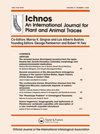Bromleyia magnifica n. igen., n. isp.: a feeding trace of a protobranch bivalve
IF 2
4区 地球科学
Q4 PALEONTOLOGY
Ichnos-An International Journal for Plant and Animal Traces
Pub Date : 2023-01-02
DOI:10.1080/10420940.2023.2222224
引用次数: 0
Abstract
Abstract The new ichnotaxon Bromleyia magnifica n. igen., n. isp., attributed to the feeding activity of bivalves, is proposed. This ichnotaxon consists of clusters of closely spaced curved ridges that form a fan-shaped structure oppositely distributed on both sides of a longitudinal axis or, more rarely, being present only on one side. Intergradation between Protovirgularia, Lockeia, and Bromleyia forms a compound trace fossil that records the activity of a cleft-foot protobranch bivalve while burrowing, moving through the sediment, and stopping to deposit feed. A specimen from the Carboniferous of Arkansas, previously regarded as Lophoctenium isp., is here included in Bromleyia magnifica. The spreite in Lophoctenium reflects complex behavioural patterns of horizontal strip-mining deposit feeders, including bundles of tubes bending to one side in a pectinate way or arranged on both sides in a highly systematic fashion, which contrasts with the coarse, horizontal fan-shaped, curved bundle of ridges from the Arkansas specimen. The trace fossil Hillichnus lobosensis records the activities of tellinacean deposit feeders and displays feather-like spreite structures reminiscent of Bromleyia. However, the spreite in Hillichnus is more organized, recording repetitive probing through the sediment in horizontal, oblique, and vertical directions of the tubular inhalant siphon. The resulting complex feeding structure, recorded in multiple preservational tiers, displays an alternate arrangement of ridges on either side of an axial basal structure. This configuration differs from the mostly horizontal, less-organized, coarse bundle of ridges with broadly opposite distribution to the sides of an axis present in Bromleyia. Moreover, contrary to Hillichnus, Bromleyia is commonly associated with Lockeia, indicating significant differences in burrowing strategy and mode of construction between these two ichnotaxa.凤尾花,名词;原枝双壳类动物的进食痕迹
摘要/ Abstract摘要:新技术分类群凤梨(Bromleyia magnifica n. igen)。,名词;,归因于双壳类动物的摄食活动。这种鱼分类群由密集的弯曲脊群组成,形成扇形结构,相反地分布在纵向轴的两侧,或者更罕见地只出现在一侧。Protovirgularia, Lockeia和Bromleyia之间的整合形成了一个复合的痕迹化石,记录了一个裂脚原枝双壳类动物在挖洞、在沉积物中移动和停下来存放食物时的活动。阿肯色州石炭纪的标本,以前被认为是Lophoctenium isp。在这里,它被收录在凤梨花中。Lophoctenium的矿体反映了水平带状开采矿床喂食器的复杂行为模式,包括以穗状方式向一侧弯曲的管束或以高度系统的方式排列在两侧,这与阿肯色州标本中粗糙的水平扇形弯曲的脊束形成对比。这一痕迹化石记录了tellinacean沉积物捕食者的活动,并显示出类似于Bromleyia的羽毛状孢子结构。然而,Hillichnus的斑纹更有组织,记录了管状吸入虹吸管在水平、倾斜和垂直方向上对沉积物的重复探测。由此产生的复杂喂养结构,记录在多个保存层中,显示了轴向基础结构两侧脊的交替排列。这种结构不同于布罗姆莱亚中大部分水平的、组织较少的、粗糙的脊束,这些脊束与轴的两侧分布大致相反。此外,与Hillichnus相反,Bromleyia通常与Lockeia有关联,这表明这两种鱼类群在穴居策略和构建模式上存在显著差异。
本文章由计算机程序翻译,如有差异,请以英文原文为准。
求助全文
约1分钟内获得全文
求助全文
来源期刊
CiteScore
2.50
自引率
12.50%
发文量
0
审稿时长
>12 weeks
期刊介绍:
The foremost aim of Ichnos is to promote excellence in ichnologic research. Primary emphases center upon the ethologic and ecologic significance of tracemaking organisms; organism-substrate interrelationships; and the role of biogenic processes in environmental reconstruction, sediment dynamics, sequence or event stratigraphy, biogeochemistry, and sedimentary diagenesis. Each contribution rests upon a firm taxonomic foundation, although papers dealing solely with systematics and nomenclature may have less priority than those dealing with conceptual and interpretive aspects of ichnology. Contributions from biologists and geologists are equally welcome.
The format for Ichnos is designed to accommodate several types of manuscripts, including Research Articles (comprehensive articles dealing with original, fundamental research in ichnology), and Short Communications (short, succinct papers treating certain aspects of the history of ichnology, book reviews, news and notes, or invited comments dealing with current or contentious issues). The large page size and two-column format lend flexibility to the design of tables and illustrations. Thorough but timely reviews and rapid publication of manuscripts are integral parts of the process.

 求助内容:
求助内容: 应助结果提醒方式:
应助结果提醒方式:


